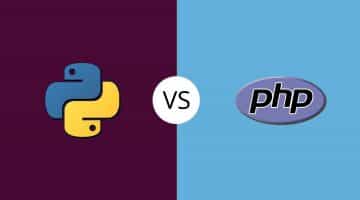Introduction:
Two of the most common backend technologies for web apps are PHP and Node.js. Since PHP is the older of the two, it inherently has a wider population and more significant projects. According to the study, the PHP community has begun to notice a shortage of current and related initiatives. Surprisingly, this is where Node.js has seen the greatest success: in establishing a large user base through projects designed for modern use cases. About the fact that both systems were introduced at different times and in different technological environments, they have some striking similarities. For example, both are considered good backend alternatives for web apps, are open-source, and have a sizable support group.
Enterprises with previous PHP projects, on the other hand, prefer it to others, while Node.js, with its rapidly growing libraries and frameworks, is a favorite among developers addressing modern-day problems. Choosing one technology over the other would have a direct effect on time-to-market, resource use, product efficiency, budget, and much more, due to their intertwined design and significant discrepancies. Read here more about Node.js and PHP.
1. Coding:
Node.js
On the surface, Node.js seems to take more lines of code to perform the same tasks as PHP. Since the whole programming environment is written in JavaScript, you won’t have to remember the vocabulary of various languages when coding. So, though Node.js require longer lines of code on occasion, it only works for one language.
PHP
PHP has been around for a long time and has grown considerably in popularity. From afar, it can seem that PHP needs fewer lines of code to execute an operation, making it simpler. However, you must be familiar with the operation of operators and generators in Linux, Apache HTTP Server, MySQL, and PHP.
2. Speed:
Node.js
Just a few asynchronous development frameworks exist, and Node.js is one of them. This is a key differentiator that sets Node.js apart from other languages. Since it’s asynchronous, it doesn’t have to wait for a module to complete until moving forward to the next. This method greatly decreases the web app’s downtime for the web design agency.
PHP
PHP, like other pre-2000 languages and systems, is focused on synchronicity. This ensures that each module and method is run in the order defined in the code. If one feature or module isn’t run, the others won’t work until it is.
3. Performance:
Node.js
Because of the asynchronous existence of Node.js and the JavaScript V8 Engine, it has a quick execution speed and a short initialization period. Since Node.js is event-driven, it does not wait for current requests to complete. Concurrency is the term used to describe this order-independent execution. Multiple modules are run at the same time but not concurrently in concurrent module execution. Simply put, even though they use the same resource and run in the same setting, their start and finish times can vary.
PHP
PHP was created in a much earlier era, as shown by how well it does in terms of page load time reliability. It halts a loop until it has completed all calculations, resulting in slow loading and no concurrency. If you do want to use PHP, you should combine it with the HHVM Virtual Machine, which is used to run PHP web applications. It will increase the efficiency of your PHP web app by nearly 75%. Despite this, Node.js is still the faster option.
4. Framework:
Node.js
Node.js has seen a huge expansion of its libraries in a comparatively small amount of time thanks to frameworks like Meteor, Derby, Express, and Sails. Although these frameworks can increase efficiency by reducing development time and resource usage, PHP frameworks vastly outnumber Node.js frameworks.
PHP
PHP, which has been around since 1995, has a large library of applications, each with its own niche market. Indeed, some programming firms specialize in PHP systems such as Laravel, CodeIgniter, CakePHP, and Phalcon.
5. Database:
Node.js
With the introduction of NoSQL databases, Node.js has been well-synchronized with all types of databases. Node.js can operate seamlessly with NoSQL databases like MongoDB and CouchDB thanks to JavaScript Object Notation, a special data type used for working with databases. It also supports graph databases and has extensive SQL database access libraries.
PHP
PHP, being a more traditional technology, is designed to work with relational and traditional databases such as MySQL and MariaDB. Though it is possible to import libraries to interact with NoSQL databases, the process is lengthy and takes a significant amount of time.
6. Request handling:
Node.js
The machine doesn’t have to wait for one process to finish before moving on to the next so multiple requests are processed asynchronously. Time spent on the CPU and RAM is therefore not lost. The main problem here is that if an unresolved error in one request is not handled promptly, it can conflict with other requests, resulting in a system-wide error.
PHP
PHP only deals with one request at a time. It absorbs more CPU and RAM energy, as anticipated. Any request is performed in a silo since it is on the opposite end of the continuum for this parameter. This stops request errors from spreading, but it causes a pause in the method due to the one-request-at-a-time approach.
When to select PHP over Node.js:
· PHP is an excellent addition to the software stack if you choose to dedicate a single unified server to your web app that would not be scaled over a larger number of servers. You can still do it for Linux and Apache.
· Although PHP limits the number of servers you can connect to successfully, it also allows for fantastic server portability. As a result, you can basically port your web app to any server that supports Apache, IIS, and other database-related features. You will basically get your website up and running in no time if you do it with content management systems like WordPress, Jumla, or Drupal.
Many of the most well-known PHP users are Wikipedia, Mail Chimp, and Tumblr. They demonstrate how much you can do with a centralized server and productive PHP use.
When to select Node.js over PHP:
· You may be using MongoDB, ExpressJS, or AngularJS to build a dynamic single-page framework. For ease of implementation and optimum efficiency, Node.js is commonly used in combination with this stack.
· Domain Callback at High Speed and Reliability- Web applications built with Node.js work better when sending requests to the server regularly. Its asynchronous design allows for non-blocking implementation and is ideal for time-sensitive projects.
Node.js has been used by companies such as Netflix, LinkedIn, and Medium for a long time. Real-time results, stable and easy access to the server, and ease of development are all common threads among the three.
About The Author
Hermit Chawla is a MD at AIS Technolabs which is a Web/App design and Development Company, helping global businesses to grow by Global Clients. He loves to share his thoughts on Web & App Development, Clone App Development and Game Development.




